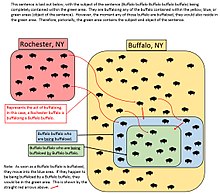|
Buffalo buffalo Buffalo buffalo buffalo buffalo Buffalo buffalo
 S = sentence NP = noun phrase RC = relative clause VP = verb phrase PN = proper noun N = noun V = verb   "Buffalo buffalo Buffalo buffalo buffalo buffalo Buffalo buffalo" is a grammatically correct sentence in English that is often presented as an example of how homonyms and homophones can be used to create complicated linguistic constructs through lexical ambiguity. It has been discussed in literature in various forms since 1967, when it appeared in Dmitri Borgmann's Beyond Language: Adventures in Word and Thought. The sentence employs three distinct meanings of the word buffalo:
A semantically equivalent form preserving the original word order is: "Buffalonian bison whom other Buffalonian bison bully also bully Buffalonian bison." Sentence construction The sentence is unpunctuated and uses three different readings of the word "buffalo". In order of their first use, these are:
The sentence is syntactically ambiguous; one possible parse (marking each "buffalo" with its part of speech as shown above) is as follows: Buffaloa buffalon Buffaloa buffalon buffalov buffalov Buffaloa buffalon. When grouped syntactically, this is equivalent to: [(Buffalonian bison) (Buffalonian bison intimidate)] intimidate (Buffalonian bison). Because the sentence has a restrictive clause, there can be no commas. The relative pronouns "which" or "that" could appear between the second and third words of the sentence, as in Buffalo buffalo that Buffalo buffalo buffalo buffalo Buffalo buffalo; when this pronoun is omitted, the relative clause becomes a reduced relative clause. An expanded form of the sentence that preserves the original word order is: "Buffalo bison that other Buffalo bison bully also bully Buffalo bison." Thus, the parsed sentence claims that bison who are intimidated or bullied by bison do themselves intimidate or bully bison (at least in the city of Buffalo – implicitly, Buffalo, New York):
  UsageThomas Tymoczko has pointed out that there is nothing special about eight "buffalos";[3] any sentence consisting solely of the word "buffalo" repeated any number of times is grammatically correct. The shortest is "Buffalo!", which can be taken as a verbal imperative instruction to bully someone ("[You,] buffalo!") with the implied subject "you" removed,[4]: 99–100, 104 or, as a noun exclamation, expressing e.g. that a buffalo has been sighted, or as an adjectival exclamation, e.g. as a response to the question, "where are you from?" Tymoczko uses the sentence as an example illustrating rewrite rules in linguistics.[4]: 104–105 OriginThe idea that one can construct a grammatically correct sentence consisting of nothing but repetitions of "buffalo" was independently discovered several times in the 20th century. The earliest known written example, "Buffalo buffalo buffalo buffalo", appears in the original manuscript for Dmitri Borgmann's 1965 book Language on Vacation, though the chapter containing it was omitted from the published version.[5] Borgmann recycled some of the material from this chapter, including the "buffalo" sentence, in his 1967 book, Beyond Language: Adventures in Word and Thought.[6]: 290 In 1972, William J. Rapaport, then a graduate student at Indiana University, came up with versions containing five and ten instances of "buffalo".[7] He later used both versions in his teaching, and in 1992 posted them to the LINGUIST List.[7][8] A sentence with eight consecutive buffalos is featured in Steven Pinker's 1994 book The Language Instinct as an example of a sentence that is "seemingly nonsensical" but grammatical. Pinker names his student, Annie Senghas, as the inventor of the sentence.[9]: 210 Neither Rapaport, Pinker, nor Senghas were initially aware of the earlier coinages.[7] Pinker learned of Rapaport's earlier example only in 1994, and Rapaport was not informed of Borgmann's sentence until 2006.[7] Versions of this linguistic oddity can be constructed with other words which similarly simultaneously serve as collective noun, adjective, and verb, some of which need no capitalization (such as "police").[10] See alsoGeneral:
Other linguistically complex sentences:
References
External linksLook up buffalo in Wiktionary, the free dictionary.
|